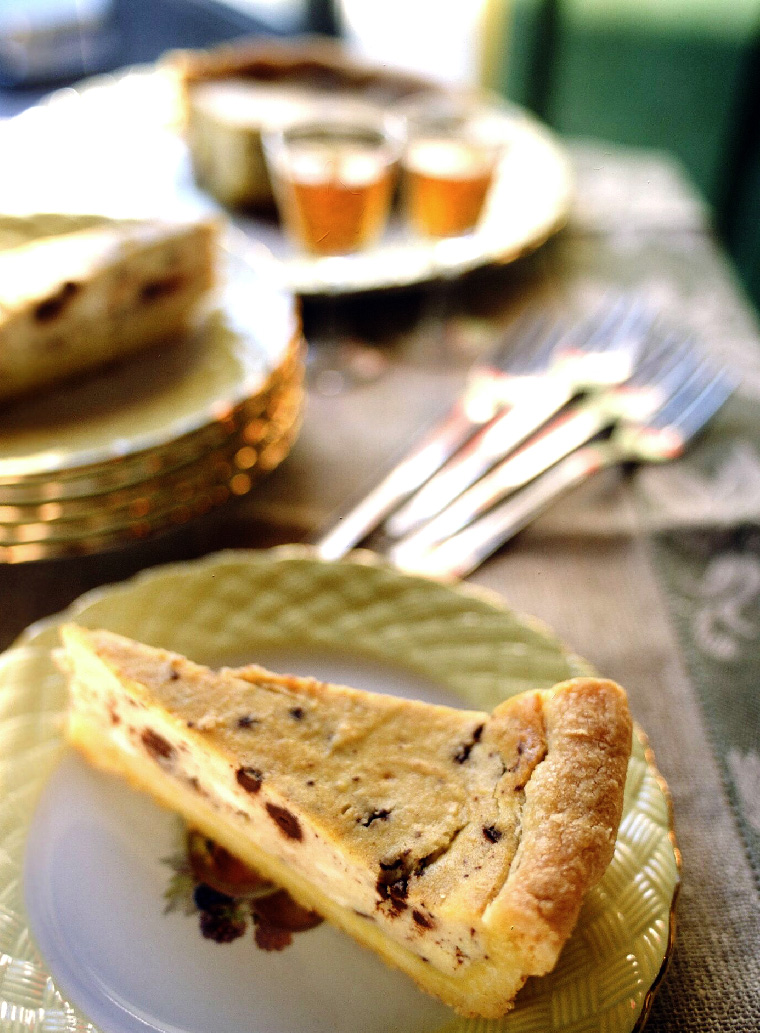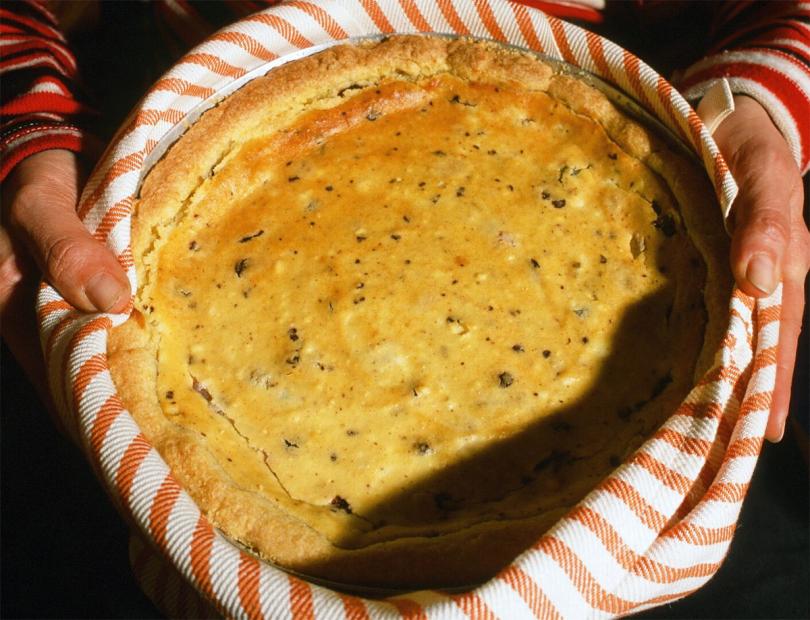Even if the sweets associated with Italian Easter—colomba, Sicilian marzipan lambs, yeast breads with colorfully dyed eggs baked into them, to name the most familiar—are a memory soon after the holiday, one cake that is emblematic of the season persists throughout the year: crostata di ricotta, Italy’s answer to cheesecake. The version I love best, inherited from my paternal aunt, a renown baker in her Long Island circles, is a hybrid of my Italian grandmother’s traditional open-faced ricotta pie, and American ingredients: The crust is a classic pasta frolla, a sweet, cookie-like dough, while the silky filling is a blend of cream cheese whipped with cow’s milk ricotta and studded with chocolate bits and candied peel (the traditional filling is made using the tangier sheep’s milk ricotta of the Italians, and heavy cream). It was a recipe she developed over a lifetime of baking, ever tweaking and refining it until she felt it had reached perfection.
Nettie Messina’s Cheesecake
Serves 8 to 10
The filling can be made in a stand mixer in minutes. It should be made at least a day or two in advance—to “ripen,” in my aunt’s words—but it will keep up to 1 week, chilled.
For the pasta frolla crust:
·2 cups sifted pastry flour or unbleached all-purpose flour
·½ cup sugar
·Pinch of salt
·½ cup (1 stick) cold unsalted butter
·1 “large” egg, beaten with 1 tablespoon milk
For the filling:
·2½ cups well-drained fresh whole-milk ricotta
·4 “extra-large” eggs
·¾ cup plus 2 tablespoons sugar
·1/3 cup all-purpose unbleached flour
·8 ounces full-fat “regular style” Philadelphia cream cheese, (or other full-fat brand), at room temperature (note: do not substitute any other type of soft cheese)
·grated zest of 1 orange
·grated zest of 1 lemon
·½ teaspoon ground cinnamon
·¼ cup rum
·¼ cup chopped candied orange rind
·¼ cup chopped bittersweet chocolate
·½ cup heavy cream
·Confectioners’ sugar for dusting

1. First make the crust: Sift the flour, sugar, and salt together into a medium bowl. Using a pastry cutter or 2 dinner knives, cut in the butter until a crumb-like mixture is formed. Using a fork, mix the beaten egg into the flour mixture until the mass is evenly moistened. Using your hands, gather the dough into a ball. Wrap it in plastic wrap and refrigerate for 1 hour or up to overnight before using.
2. Generously butter an 8-inch spring-form pan. Preheat the oven to 350º F. Sprinkle a work surface lightly with flour and roll the ball of dough into a disk 1/8-inch thick. Fit the crust into the spring-form pan and crimp the edges. Place an ample sheet of aluminum foil at least 16” x16” and center it under pan, bring the foil up and around the sides of the pan crimping the top outward foil so that it will catch any leaks during baking. Refrigerate the dough-lined pan until ready for use.
3. To make the filling, put the ricotta into a strainer and set it over a bowl for about 30 minutes; press out the excess liquid. (Note: Freshly made ricotta often has much more liquid in it than commercially processed ricotta; either one works well in this pie, as long as the liquid is completely drained.)
4. Using an electric stand mixer or a hand-held mixer and a mixing bowl, beat the eggs well. Brush some of the beaten eggs inside the bottom of the pie shell to moisture-proof it. Add the ¾ cup sugar and flour to the remaining eggs and beat 2 or 3 minutes, until thick and a light yellow color. Add the drained ricotta and cream cheese; beat until smooth, then beat in the zests, cinnamon, and rum until smooth. Sprinkle about half the fruit and chocolate mixture over the glazed pie shell. Stir the remaining fruit and chocolate into the egg-cheese mixture.
5. In a deep bowl of an electric mixer or with a whisk, whip the heavy cream with the 2 tablespoons sugar until soft peaks form. Fold it into the ricotta-fruit-chocolate mixture until blended. Pour the filling into the prepared pie shell pan and smooth the top evenly. Slide the pan onto the middle rack of the oven and bake for 1 hour and 15 minutes. Turn off the oven and leave the cake inside with the door closed for about 1 hour. Remove from the oven and let cool completely. Remove the sides of the spring-form pan. Slide the cake onto a cake platter. Cover with plastic wrap and refrigerate at least overnight before serving.
6. Before serving, dust the crostata with confectioners’ sugar. The crostata is usually cut into small slices and served with espresso.
Julia della Croce is a food writer and James Beard award-winning cookbook author and recipe developer based in New York. She is presently incubating a book about her family’s ancestral region, Sardegna. Visit her website, www.juliadellacroce.com and blog, http://juliadellacroce.com/forktales1/, connect on Facebook: Julia della Croce – chef & foodwriter, Twitter: @juliadellacroce and Instagram: juliadellacroce.





























